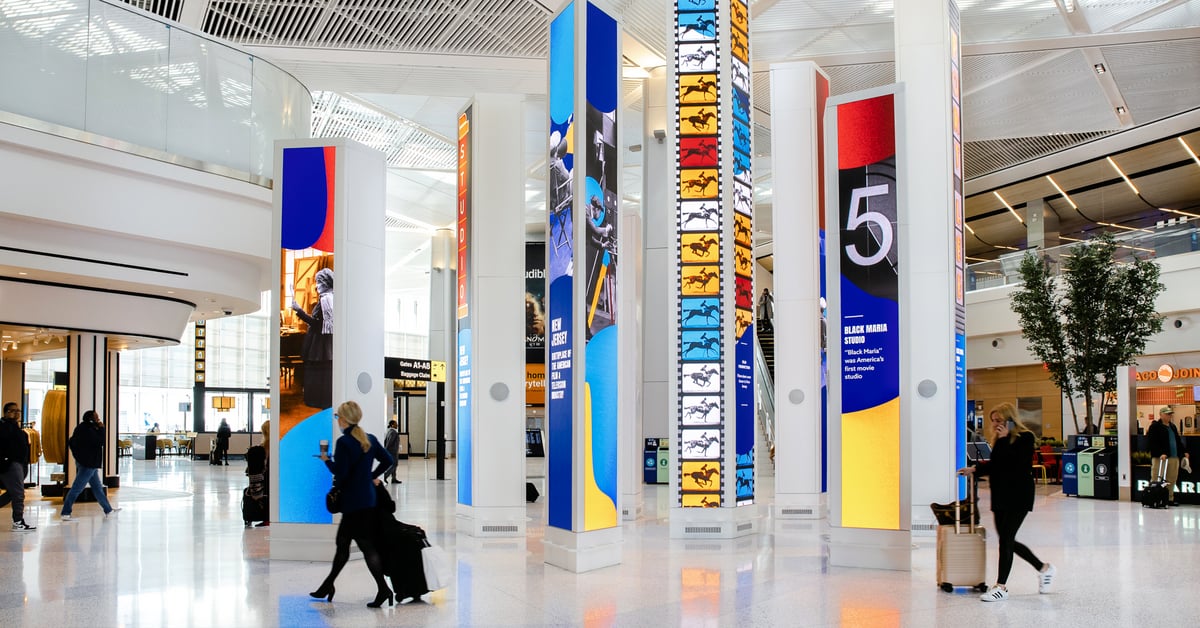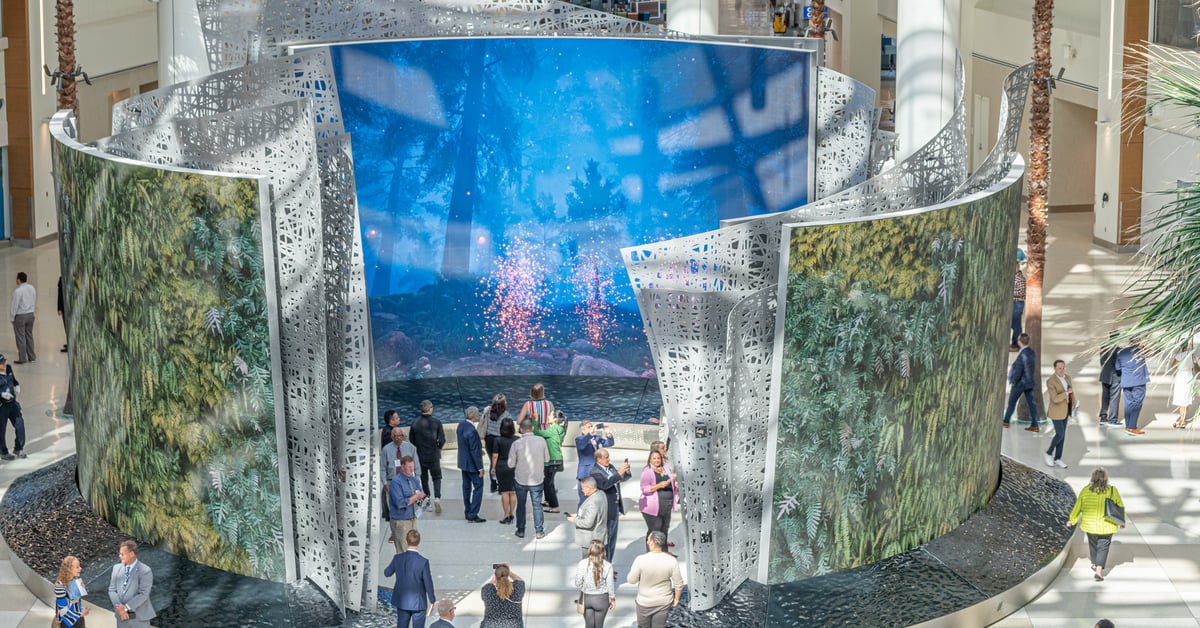
Three Airports that use innovative Experiential Technology [Case studies]
Modern, tech-savvy travelers expect airports to provide a seamless, consistent welcoming experience from arrival to boarding and terminal departure.
Experiential technology in airport terminals has become an integral element in meeting those expectations and improving passenger satisfaction as operators invest in next-generation digital facilities, services and experiences.
In this blog, we look at examples of innovative experiential technology installations at a number of leading airports.
Experiential technology transforms the passenger experienceA new Electrosonic benchmark report 'The Revolution in Post-Pandemic Airport Amenities', based on telephone interviews with more than 50 key decision makers in major airports around the US, found that 68 percent of airport development executives see experiential technology as key to improving passenger satisfaction.
That makes it essential to leverage technology at every stage in the passenger journey through the terminal to create a seamless, stress-free, positive and memorable experience. Operators recognize that these technologies can transform airport terminals from functional spaces to fun, informative environments that deliver important passenger-focused benefits.
To deliver those benefits, airport operators are investing in many different types of experiential technologies, including:
- Digital wayfinding systems
- Passenger information systems
- Digital signage
- Multimedia installations
- Video walls and LED pylons
- Projection-mapped installations
- Interactive displays
- Digital statues
- Specialty audio
- Digital advertising installations
- AI-enabled interactive experiences
- Extended reality experiences
- And more...
Informational displays
Tom Bradley International Terminal at Los Angeles International Airport has taken passenger experience to new levels with an award-winning Integrated Environmental Media System (IEMS). The IEMS was the first full integration of broadcast audiovisual, enterprise-grade information technologies and show-control technologies to manage interactive data-driven content across multiple features and platforms.
Electrosonic integrated creative digital media features into the architecture of the terminal, providing passengers with essential information that was entertaining as well as informative. The features included:
- A massive Welcome Wall that displays scenes of greeting and stunning atmospherics.
- The Bon Voyage Wall which provides a unique send-off with images expressing LA’s diversity, creativity and energy.
- The Destination Board, a generative LED video ‘data cloud’ displaying flight information and visual data on destination cities.
- A 120-foot-long Story Board that displays content based on the art traditions of destination cities around the world.
- Two interactive ‘Concourse Portals’ consisting of 10 video columns which respond to the movement of passers-by and update in real-time with information about departing flights, offering custom experiences for travelers bound for the terminal’s 15 most popular international destinations.
At the new Terminal A at Newark Liberty International Airport, 33 triangular digital pylons at the departure gates provide an entertaining experience within a highly functional space. The pylons feature LED on two faces to communicate a mix of practical flight information, intuitive boarding cues and fun-filled New Jersey facts, quizzes and trivia.
Placemaking installations
In addition to improving passenger experience and operational efficiency, leading airports are also placing greater emphasis on their placemaking role. Placemaking installations welcome passengers, connecting with them and helping make the terminal part of a destination that people want to visit.
At Newark International Airport, multimedia installations showcase the best of the state of New Jersey:
- In the departure hall, an LED welcome banner 230 feet by 8 feet integrated with the architecture above the check-in line creates surprising transitions, opening from what appear to be ceiling tiles to a series of New Jersey-themed vignettes.
- The ‘Forest of Firsts’ - eight towering multimedia LED pillars ranging from 20 to 30 feet high - engage travelers immediately with dynamic images that celebrate the state’s spirit of innovation in science and literature.
- In the Welcome Center, a huge ‘NJ’ sign over 12 feet high dominates the space. An LED outline around the letters pulses with light attracts attention and makes an unmissable statement about the destination.
At Orlando International Airport Terminal C, travelers’ eyes are drawn to ‘Windows on Orlando’ - three 32-foot-high LED screens spanning 114 feet displaying stunning scenes of Orlando and central Florida. Video playback on the massive screens celebrates the region with alluring large-scale imagery and audio, immersing travelers in local views of their destination. Video intensity adjusts automatically in line with prevailing light conditions.
Entertainment and attractions
Many leading airports are deploying large, scale immersive and interactive installations that engage attention and create memorable experiences for passengers. Many of these installations draw on the techniques and technology of themed entertainment to create a lively, fun atmosphere. Electrosonic’s benchmark report found that 82 percent of airport respondents are considering major technology-enabled attractions.
At the Tom Bradley Terminal at LAX, a 72-foot high Time Tower entertains and informs with content exploring time as part of the travel experience with a universal world clock creating a three-dimensional representation of 24 world time zones.
The ‘Moment Vault’ at Orlando International Airport is an interactive 360-degree immersive experience. It features dual-sided LED walls and uses motion capture powered by artificial intelligence to integrate passenger silhouettes with dynamic content. Six individual 15 feet x 35 feet LED screens mounted back-to-back in a circular shape create an immersive, interactive 360-degree space.
Screens on the outside can play different content from those on the inside, while carefully positioned speakers deliver the audio. In the interior space, an AI-based motion capture system generates a 3-dimensional pose estimate for each individual passenger, using the data to integrate virtual avatars with digital content in real-time. Breakthrough technology, photorealistic content and AI software create a unique digital installation - the first of its kind in an airport terminal.
Elevating the airport brand
Experiential technology like the examples we’ve described is transforming the passenger experience, providing information, entertainment and fun for passengers throughout their time at the terminal. The technology elevates the airport’s brand while placemaking installations build a positive attitude towards the local region. In fact, at Newark International Airport, the impact on passenger experience has been so strong that the operators now consider the installation's mission critical.
Photography of Los Angeles International’s Tom Bradley International Terminal and Newark Liberty International Airport - Terminal A courtesy of Moment Factory.
Brandon Harp
Brandon Harp, Senior Business Development Manager at Electrosonic focuses on Airports, Transportation, Corporate and Retail verticals. He has a unique ability to look at technology through a creative lens with a consistent passion and determination to develop innovative and impactful solutions for clients. Brandon quickly identifies challenges and pain points by listening and communicating effectively. He is a knowledge expert, a problem solver, a thought leader, and a trusted advisor who always keeps the client’s best interests at heart. Brandon understands the importance of design, architecture, content, storytelling and experience and he is constantly looking for new and innovative ways of pushing the boundaries around what is possible.










.jpg?width=1500&height=995&name=ELC501_N17_medium%20(1).jpg)

.jpg?width=1200&height=629&name=ELC67_N89_cropped_1200x629%20(1).jpg)


![[Discover 50 Airport Executive Insights into passenger experience investment - Benchmark Report]](https://no-cache.hubspot.com/cta/default/5104351/7264d0bd-defe-49ca-9dca-d2f783d167bd.png)








































































































































































































